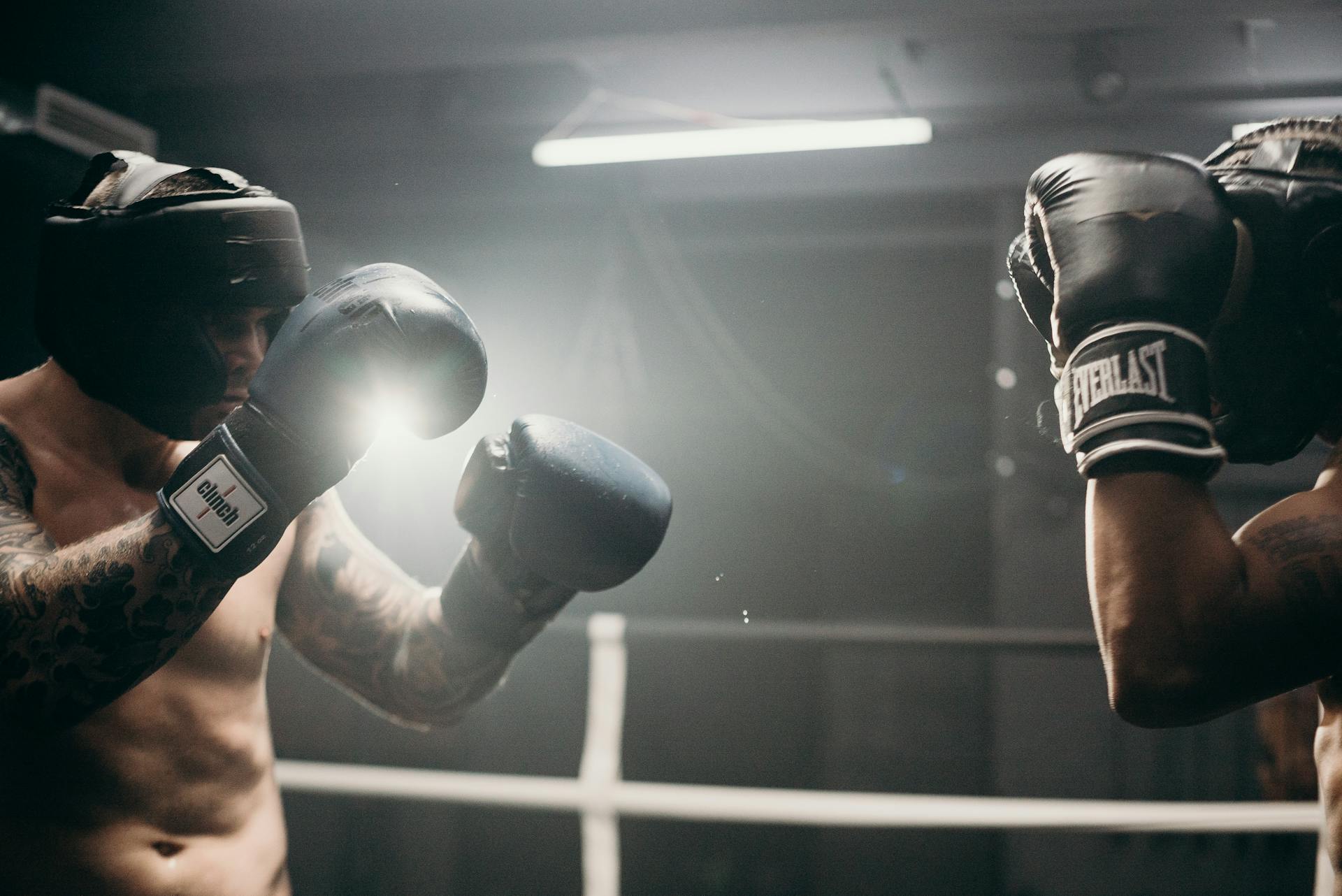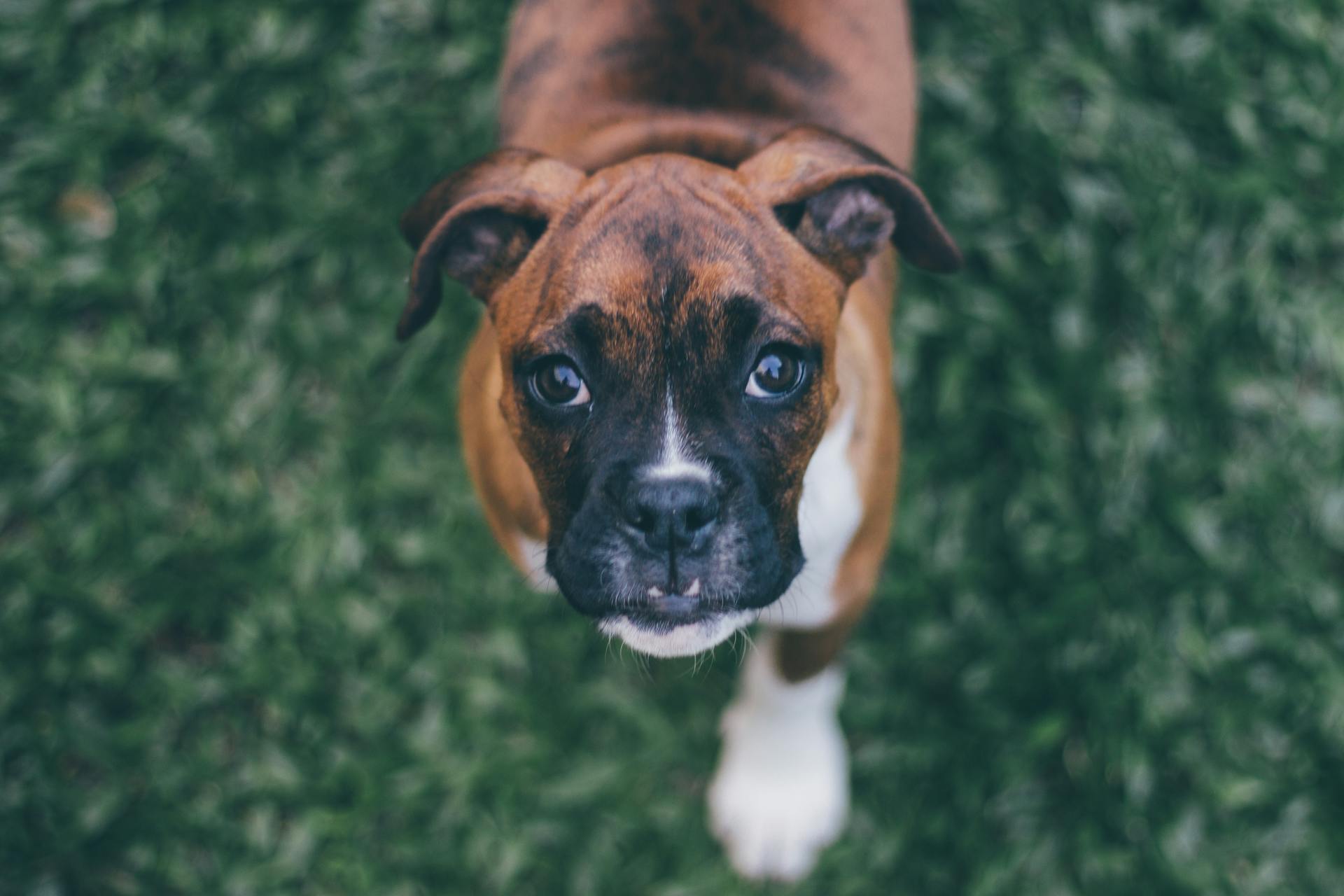
The Boxer show dog breed is a popular and iconic one, known for its distinctive appearance and charming personality. Boxers are a medium-sized breed, typically weighing between 60-70 pounds and standing between 20-25 inches tall at the shoulder.
Their short, smooth coat requires minimal grooming, making them a great choice for busy owners. Boxers are also known for their high energy levels and need plenty of exercise to stay happy and healthy.
In terms of temperament, Boxers are often described as friendly, outgoing, and patient, making them a great breed for families with children. They're also highly intelligent and trainable, but can be strong-willed at times.
One thing to keep in mind is that Boxers are prone to certain health issues, such as heart problems and allergies, so regular veterinary check-ups are a must.
Explore further: Types of Great Dane Dog
About This Breed
The Boxer breed has a rich history that dates back to the 19th century, originating from the German Bullenbeisser.
This breed was used to hunt large game such as bear, boar, and deer, and was later crossed with the Bulldog to create the foundation for the modern Boxer.
The Boxer's intelligence and character make them an excellent family companion, and their loyalty and protective instincts also make them a great guard dog.
Their clean outline, glossy coat, and noble head and expression have won over many admirers, and it's easy to see why.
The Boxer has also proven itself to be a capable tracking dog and has even worked in the armed forces as a messenger and pack carrier.
Physical Characteristics
Boxers have a short, glossy coat that's soft to the touch, usually in fawn, brindle, or white colors. Their coat is often flecked with white across the chest, face, and paws.
Their square head is a unique feature, lifted high above a strong back and tapered hindquarters. This distinctive head shape is a key characteristic of the breed.
Consider reading: Dog Hair Types
Most boxers have broad, black faces, also known as masks. Their ears create a floppy frame around their masks, although some owners have traditionally cropped the ears so they stand up.
Boxers weigh between 50-80 pounds and top off at nearly 2 feet high at the shoulder, making them medium- to large-sized dogs.
Here are the key features of a boxer's head, according to the breed standard:
- Ears: Floppy or cropped
- Face: Broad, black (mask)
- Eyes: Dark brown, frontally placed
- Nose: Broad and black with a blunt muzzle
- Coat: Short and tight-fitting
- Coat Color: Fawn and brindle
- Tail: Docked or natural
Their muscular build and compact body make them appear lively and powerful.
Breed Standard
The Boxer breed has a rich history, and one of the most important aspects of the breed is its standard colors. The breed standard colors are the traditional and well-known colors accepted within the breed standard.
These colors are a key factor in determining a Boxer's eligibility to participate in dog shows. The breed standard colors include a wide range of patterns and shades.
Here's a breakdown of the breed standard colors:
The breed standard colors can vary in pattern and shade, but they must always meet the breed standard requirements.
Health and Care
Boxers are generally low-maintenance when it comes to grooming, but they do need regular brushing to control shedding.
They only need a bath about once a month, and that's a good time to trim their nails and clean their ears. Some boxers have deeper facial folds than others, so you might need to wipe these clean with a damp washcloth.
Boxers can be sensitive to hot temperatures, so time walks in the early morning or late evening when the sun isn't at its hottest is a good idea. If you notice your boxer is a bit overheated, apply chilled water to his ears, belly, and genitals.
You might enjoy: When Is Best Time to Breed Dog
Health
Boxers have some unique health needs, especially when it comes to temperature regulation. They often need sweaters or jackets to protect them in cold weather.
Their short coats can't provide enough insulation, and their snub noses and fleshy mouths can't cool them down as efficiently as other dogs. So, if it's warm out, it's best to take walks in the early morning or late evening when the sun isn't at its hottest.

Boxers are also prone to overheating, so it's essential to keep an eye on them and apply chilled water to their ears, belly, and genitals if they start to overheat. This can help bring down their body temperature quickly.
Cardiomyopathy is a significant health issue in boxers, particularly arrhythmogenic right ventricular cardiomyopathy (ARVC), which affects nearly 40 percent of the breed. This genetic disease can cause an irregular heartbeat, fainting, shortness of breath, and difficulty exercising.
Other potential medical conditions in boxers include hip dysplasia, degenerative myelopathy, thyroid issues, and tumors. Regular check-ups with a veterinarian can help identify these issues early on.
A boxer's lifespan is usually 10-12 years, so it's crucial to schedule regular check-ups with your veterinarian at various stages of life. This will help prevent problems and ensure your boxer stays healthy and happy.
Care
Boxers are relatively low-maintenance pets, but they do need regular dental care to prevent tartar buildup. Clean your boxer's teeth every day if possible.

Their coat is another area that requires some upkeep. Brushing your boxer's coat a couple of times a week with a hound glove or rubber curry-brush will keep it sleek and shiny.
Boxers don't shed a lot, but regular brushing helps control any fur that does fly. You can bathe your boxer about once a month, and that's a good time to trim their nails and clean their ears, too.
Some boxers have deeper facial folds than others, so you might need to wipe these clean with a damp washcloth, especially after a vigorous romp outside nosing through dirt.
Worth a look: Smooth Haired Fox Terrier Puppies
Breed Club and History
The Boxer breed has a rich history that spans thousands of years. The breed's ancestors were Assyrian empire war dogs, dating back to 2,500 BC.
The Boxer breed was developed from the Bullenbeisser, a German breed used for hunting large game. The Bullenbeisser was later crossed with the English Bulldog to create the modern Boxer.
The American Kennel Club recognized the Boxer breed in 1904, and the breed's popularity grew rapidly. A Boxer named Sigurd was one of the first boxers in the US and won Best of Breed at the Westminster Dog Show in 1935.
Breed Club Actions

Breed Club Actions are a crucial part of ensuring the health and well-being of the Boxer breed.
The Kennel Club and Boxer breed clubs are working together to monitor research related to juvenile kidney disease and are looking to secure funding for this research through the Kennel Club Charitable Trust.
The breed clubs are also committed to encouraging participation in breed club heart testing, which is a vital scheme for the breed's health. This testing scheme is available on the Boxer Breed Council website for those interested in learning more.
The breed clubs are actively engaged in brachycephalic obstructive airway syndrome (BOAS) research with the University of Cambridge team, and this project is currently in progress.
History of
The Boxer breed has a rich history that spans thousands of years. It originated from ancient war dogs in the Assyrian empire in 2,500 B.C.
The breed's modern ancestor, the Bullenbeisser, was a large game hunter and cattle controller in 19th century Germany and Belgium. It was bred from other dogs, including the mastiff and English bulldog.
The name "Boxer" comes from the breed's role in slaughterhouses, known as "boxl", or from its playful behavior using its front paws.
The American Kennel Club officially recognized the Boxer breed in 1904.
Temperament and Grooming
Boxers are known for their friendly and outgoing personalities. They thrive on interaction and attention, making them a great breed for families with children.
To help your Boxer develop good manners, it's essential to introduce them to various adults, children, and other pets from an early age. This will help them become confident and calm in new situations.
Boxers can be prone to getting into mischief if left alone for too long, which is why crate training is crucial. Crate training not only helps to curb undesirable habits but also provides a sense of security for your Boxer.
Here's a quick rundown of Boxer grooming needs:
- Brush their coat a few times a week to keep shedding in check and their coat healthy.
- Clean their teeth daily to prevent tartar buildup and dental disease.
- Bathe them once a month, unless they get really dirty, and trim their nails at the same time.
Temperament
Boxers are naturally friendly and fun dogs, but they can be suspicious around new people and animals, so socialization is key.
They reach full maturity in about three years, which is longer than other dog breeds, and require positive reinforcement training to channel their abundant energy.

Boxers are easy to train and eager to please, responding well to cues and leash training.
Their curious minds need to be kept engaged, so teaching them new tricks regularly is a must.
Boxers were bred to be working dogs, so they can get restless if left alone for hours and may get into mischief.
Crate training is essential to curb undesirable habits caused by boredom and provide a sense of security.
Boxers will often find ways to entertain themselves if left unattended, so crate training is a must.
Boxers can be sensitive, so they need to be handled with care.
They'll work hard to please their loved ones, but this desire to please means they can get their feelings hurt.
Boxers are known to be quite sensitive, so it's essential to be gentle and understanding.
They can get along well with kids and other pets, but may not get along with dogs they don't know and of the same sex.
Boxers are intelligent and athletic, making them perfect for roles like service, assistance, and therapy dogs.
Additional reading: How Much Exercise Do Boxer Dogs Need
Grooming
Grooming is an essential part of being a Boxer owner. Brushing their coat a few times a week can help keep shedding in check.
You'll want to use a rubber curry brush or a hound glove for this task. This will also help keep their coat healthy and tight to the skin.
Don't forget to brush their teeth daily to prevent tartar buildup and dental disease. This is an easy habit to get into and will save you a lot of trouble in the long run.
Unless they get really dirty, Boxers only need to be bathed once a month. You can turn this into a doggy spa day and trim their nails at the same time.
Intriguing read: Bernese Mountain Dog Coat
Frequently Asked Questions
Has a Boxer ever won the dog show?
Yes, a Boxer has won the Westminster Kennel Club Dog Show four times, in 1947, 1949, 1951, and 1970. This impressive achievement showcases the breed's excellence in dog shows.
What dog show group is Boxer?
The Boxer is a member of the Working Group in dog shows. This group boasts impressive records, including the most consecutive Group wins.
What dog breeds make up a Boxer?
Boxers are a mix of extinct Bullenbaiser breeds, Mastiff, Bulldog, and possibly Great Dane and Terrier. This unique combination of breeds was developed in 19th century Germany for various tasks.
Featured Images: pexels.com


